Types of Chemical Peels
What are the different types of Chemical Peels?
When it comes to revitalizing the skin, chemical peels are the most common cosmetic treatment in the world of dermatology. Chemical peels are a customizable way to treat many skin conditions, including acne scars, age spots, discoloration, fine lines and wrinkles, melasma, and even rosacea. Chemical peels are designed to exfoliate the skin and eliminate dead skin cells from the top layer, allowing for healthier, younger-looking skin. Dr. Michele Green was one of the first dermatologists in NYC to incorporate TCA, Cosmelan peels, Glycolic acid, and salicylic acid peels to treat melasma and other disorders of hyperpigmentation in her boutique New York City dermatology practice.
The American Academy of Dermatology specifies three different types of chemical peels. The different types are determined by the strength of the chemical peel and how deeply the layers of skin are affected. The three major classifications of chemical peels are light or superficial peels, medium-depth peels, and deep chemical peels. Within those three major classifications are four common types of peels: Alpha Hydroxy acid peels, Beta Hydroxy acid peels, Trichloroacetic Acid Peels (TCA), and Phenol peels.
Chemical Peels contain a tailored chemical solution designed to target specific skin care needs and range in depth and intensity of treatment. Board-certified dermatologist Dr. Michele Green, in NYC, has over 25 years of experience treating patients with chemical peels and determines the best type of chemical peel for each patient based on your skin type and skin care needs. When developing a treatment plan, Dr. Green customizes your skincare routine with a combination of the best skincare products, cosmetic procedures, and types of chemical peels tailored especially for you. Choosing the correct chemical peel for your skin type and condition is the most important aspect of chemical peel treatment. If you’re interested in revitalizing your skin through chemical peels, contact the NYC office of Dr. Michele Green today to learn what the best options are designed specifically for you.
What is a chemical peel?
A chemical peel is a cosmetic procedure consisting of an acid-based solution that is applied to the skin’s surface to exfoliate damaged skin cells and promote skin cell turnover to reveal smooth, clear, evenly textured skin. Many different types of chemical peels range in concentration and active ingredients that can serve different skincare functions. Depending on the type of chemical peel used, the treatment can work to address active acne outbreaks, reduce the appearance of hyperpigmentation, such as dark spots, age spots, and melasma, and improve skin tone and skin texture. As it is a highly effective and adaptable treatment, chemical peels are in the top five most popular cosmetic treatments in the United States.
How do chemical peels work?
A chemical peel is a type of skin resurfacing treatment that uses a chemical solution to remove the outer layers of dead skin. Through a process of chemical exfoliation, chemical peels can stimulate cell turnover, which in turn unclogs pores and corrects skin discoloration, giving the skin a vibrant glow. The chemical solution is applied to the skin’s surface and targets the top layers of the skin to eliminate dead skin cells and damaged skin cells. This “controlled trauma” to the skin stimulates the natural peeling of the skin, which can improve the texture of the skin for a variety of skin types. Chemical peels rely on various acid types, including glycolic acid, lactic acid, salicylic acid, and trichloroacetic acid (TCA). The depth and effect of the peel vary depending on the intensity and make-up of the chemical peel.
The FDA has approved chemical peels for decades, and this skincare treatment has existed since the 19th century. They are used today to create a customizable skin treatment that can reduce aging signs and revitalize irritated skin with minimal downtime. Specifically, chemical peels can be used to reduce the appearance of fine lines and wrinkles, eliminate the appearance of hyperpigmentation, including melasma and age spots, and rid the skin of acne and acne scars. The concentration and active ingredients in the different types of chemical peels can address varying skin conditions for rejuvenation and hydration of the skin.
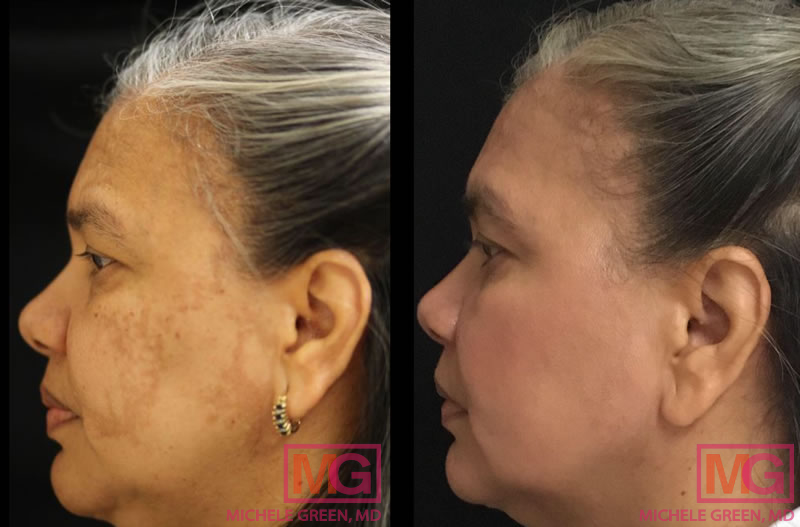
What types of chemical peels are there?
The types of chemical peel for the face are incredibly varied, each tailored to the patient’s needs. The peels are divided into a few different categories that address the depth of the treatment, light, medium, and deep chemical peels. The peel’s strength is determined by the skin texture and tone and the skin problem one is trying to address. Melasma and hyperpigmentation require a different type of peel from fine lines and deeper wrinkles. In addition, darker skin tones require more gentle chemical peels than lighter skin types.
Light Chemical Peels
Light chemical peels, or superficial peels, are formulated with mild peeling agents to exfoliate the skin gently. The lightest chemical peels have an exfoliating chemical solution that only affects the top layer of the skin (epidermis).
What are the different types of superficial peels?
When it comes to superficial peels, a few common acids are used. Alpha Hydroxy acid peels are considered the most gentle form of chemical peel, which can help to reduce the appearance of very fine lines, dry skin, minor acne, and mild pigment or uneven skin tone. Beta Hydroxy acid peels have lipid-based chemical solutions that help control oil production, which can be particularly useful for those with naturally oily or acne-prone skin.
Jessner’s peels combine lactic acid, salicylic acid, and resorcinol to move acids deeper into the layers of the skin. Jessner’s peels are often followed up with the application of retinoid acid. Retinoid acid (retinol) provides a deeper peel penetration, which can help to trigger faster skin healing and new skin growth.
Alpha Hydroxy acid (glycolic acid) Peels
Alpha Hydroxy acids (AHA) refer to a variety of different acids, including citric acid (from citrus fruits), lactic acid (from fermented milk), magic acid (from apples), and tartaric acid (from grapes). However, the most popular AHA peel is a glycolic acid peel to exfoliate the skin and stimulates collagen production. Glycolic acid, derived from sugar cane, has a very small molecular structure that allows it to penetrate the layers of the skin and varies in strength to balance active exfoliation with skin sensitivity.
Beta Hydroxy acid (salicylic acid) Peels
Beta Hydroxy acid Peels, or BHA peels, are an excellent option for those hoping to reduce the appearance of blemishes or congested skin. The lipid base of BHA peels can reach farther than many AHA peels, as the solution can penetrate deeper layers of the dermis by attaching to the skin’s natural oils. Salicylic acid, the most common acid in BHA peels, acts as a clear-out for the pores and has anti-inflammatory characteristics that reduce irritation due to acne breakouts.
Jessner’s Peels
Jessner’s peels can vary by strength depending on the percentages of the acids used. Jessner’s peels can also contain additional acid combinations, such as mandelic acid (from almonds) for anti-inflammatory benefits, phytic acid to treat patients with sensitive skin, or lactic acid to brighten and hydrate the skin. Oftentimes, for patients with rosacea, chemical peels can be tailored with a solution that includes phytic, mandelic, and lactic acids.
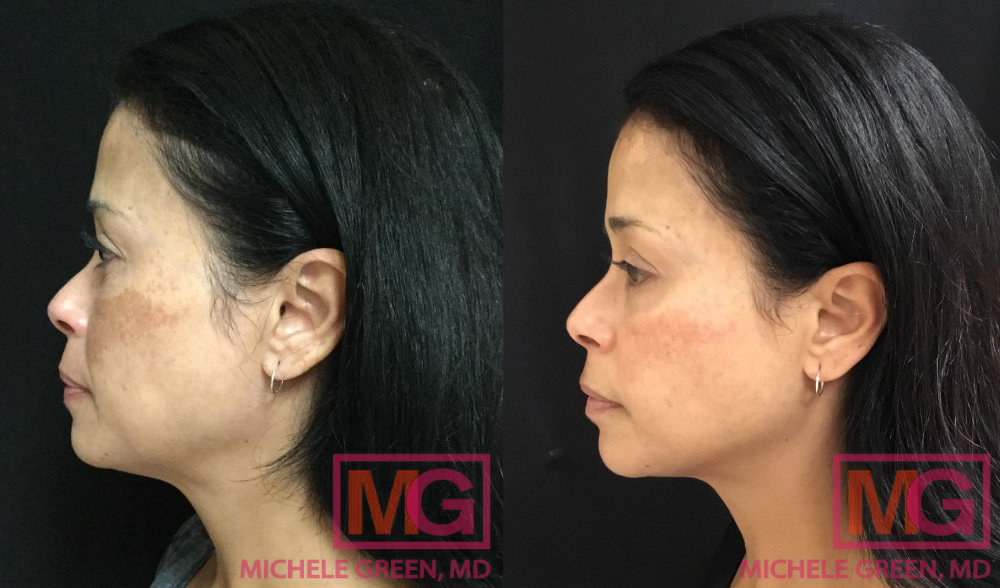
Medium Depth Peels
Medium chemical peels vary in terms of chemical solution, but the most common medium-depth peel is a Trichloroacetic acid peel.
Trichloroacetic Acid Peels (TCA)
Trichloroacetic acid or TCA peels are offered in various strengths and combinations. TCA can be combined with salicylic acid, among others, at a lower percentage within a solution. However, when the TCA percentage exceeds 20%, it is administered solely by a medical professional, such as Dr. Green. TCA peels are an excellent choice for patients who experience pigment irregularities, sun damage, deep wrinkles, and acne scars. Additionally, TCA peels can be used to treat pre-cancerous growths on the skin, also known as actinic keratosis.
Deep Peels
Deep peels are designed to penetrate deeper into the layers of the dermis. Deep chemical peels tend to require more recovery time, but they offer long-lasting, dramatic facial rejuvenation.
When considering a deeper peel, patients may also consider laser resurfacing as a means to reinvigorate the skin. Laser resurfacing has become a popular treatment for convenient, safe, and successful skin rejuvenation.
Phenol Peels
Phenol peels use carbolic acid as their peeling agent. Phenol peels have perhaps the strongest chemical peel solution to produce the most dramatic results, and the concentration of carbolic acid can shift or be combined with resorcinol or salicylic acid to a wonderful effect. Due to the intensity of the phenol peel, results can be transformative, but in some concentrations, a phenol peel can only be administered once in a lifetime. A phenol peel should always be administered by a board-certified physician, such as Dr. Green, for both safety and consistency of results.
What does a chemical peel look like?
A chemical peel consists of a solution with an acidic active ingredient that is applied in a thin layer onto the skin’s surface. The procedure will begin with Dr. Green pulling back your hair, cleaning the skin of any makeup, sunscreen, or other debris, and applying a topical numbing cream. Depending on the strength of the peel, Dr. Green may apply a more intense topical anesthetic. Dr. Green’s office may also supply goggles to protect the eyes from the chemical peel solution if the peel is being applied to the face. Most chemical peels are light in color and may cause the skin to turn white after application. Patients may experience discomfort in the form of a stinging sensation for 15-20 minutes, after which Dr. Green will apply a neutralizing solution before cleaning the peel off the face.
What are the side effects of chemical peels?
The side effects of chemical peels are typically temporary and mild and include burning, dryness, redness, and swelling. After any chemical peel, particularly if you are administered a deep peel, it is essential to avoid sun exposure and apply sunscreen regularly. Though this is temporary, you may experience lighter or darker skin tone within the first few days post-treatment. Occasionally, patients experience herpes simplex (cold sore) flare-ups, for which Dr. Green can prescribe an antiviral medication.
In rare cases, side effects from chemical peels can include scarring and heart, liver, or kidney damage. These side effects are more likely to occur when the incorrect chemical peel is administered, which is why a medical professional like Dr. Green must determine a chemical solution.
What does a chemical peel burn look like?
One potential side effect of a chemical peel treatment is post-inflammatory hyperpigmentation, which is a darkening of the skin in patches at the treatment area. Post-inflammatory hyperpigmentation occurs most commonly in patients with a darker skin tone who receive a high-strength chemical peel, such as a concentrated medium-depth peel or a deep chemical peel. That is why it is always best to consult with an expert, board-certified dermatologist, such as Dr. Green, who can recommend the type of chemical peel that will be safest for your skin tone.
What does your face look like after a chemical peel?
The after-effects of a chemical peel depend largely on the strength of the peel that has been used. For patients who receive a superficial chemical peel, such as an AHA or BHA peel, there is no downtime necessary following the peel. However, patients may experience redness or skin discoloration for 4-7 days post-treatment. The recovery time for a medium chemical peel is usually between 5 and 7 days. During that time, patients may experience irritation, crusting at the treatment site, and some dark spots while the area heals and the new skin is uncovered. Deep chemical peels are the most intense type of chemical peel, so the recovery is the longest following treatment. Patients can experience redness, irritation, and burning for several weeks post-treatment and should be advised to practice strict sun avoidance during the healing process to decrease the likelihood of developing any further skin irritation.
What type of chemical peel should I get?
When determining which chemical peel is best for you, Dr. Green considers your skin condition, skin type, and concerns. Ultimately, each individual will have different needs that will lead to the correct customized chemical solution, but, in general, certain types of chemical peels are designed to target specific skin conditions.
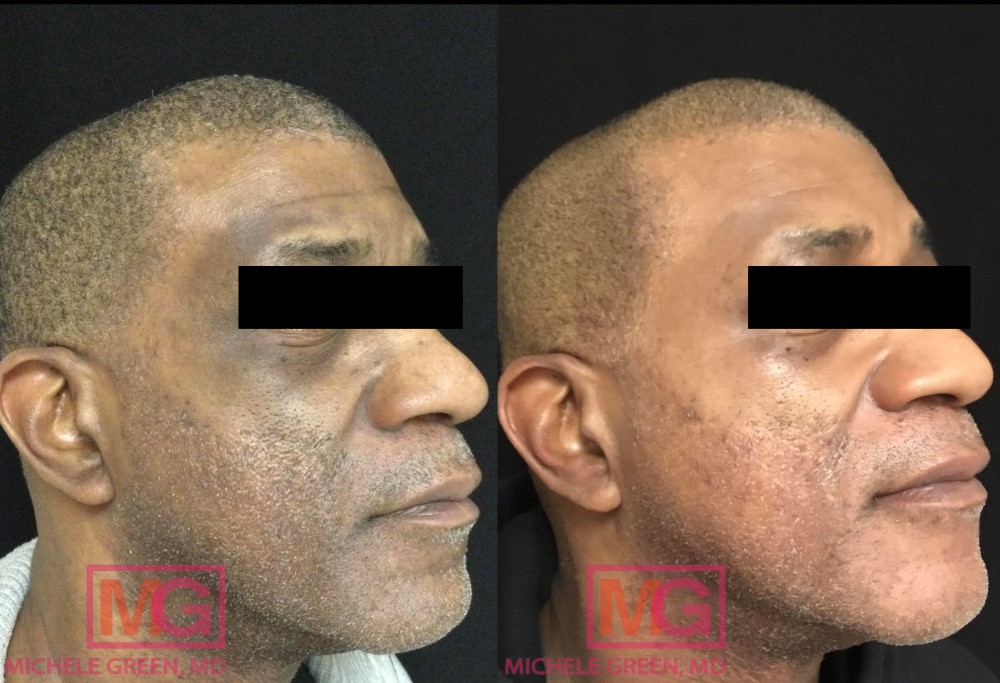
Which chemical peel is the strongest?
The strongest chemical peel type is the deep chemical peel, which is highly effective at removing pre-cancerous lesions and reducing the appearance of deep wrinkles. With a deep chemical peel, such as a Phenol peel, which consists of carbolic acid as the active ingredient, patients should expect a much longer recovery as the peel penetrates deep into the dermis. Patients with darker skin types should avoid the use of deep chemical peels to prevent post-inflammatory hyperpigmentation from occurring.
What chemical peel is best for acne scars?
Regarding acne, the best option is a superficial peel with a chemical solution of glycolic acid or light TCA concentration. These acids are designed to unclog pores, exfoliate the skin, and remove dead skin cells from the epidermis. This peeling procedure can get acne breakouts under control and clear out pimples and blemishes. BHA peels are also commonly used to treat acne, though this can cause redness and irritation for sensitive skin.
When it comes to acne scars, an AHA or TCA peel can lighten the appearance of blemish scarring when new skin is formed. Dr. Green often recommends a superficial peel in combination with her MGSkinLabs acne products, which can help to improve the appearance of acne and acne scarring further after chemical peel treatment.
What type of chemical peel should I get for wrinkles?
When it comes to reducing the appearance of fine lines and wrinkles, a Jessner’s peel, Mandelic chemical peel, and Retinol chemical peel are all excellent options. Jessner’s peel is an effective choice for those hoping to reduce the appearance of fine lines and wrinkles, melasma, hyperpigmentation, and even acne scars when used as a superficial peel. Mandelic acid is a common anti-aging peeling agent, as it encourages new skin growth and can strengthen collagen in the skin to provide smoother, firmer skin. Retinol is a very popular skincare ingredient, as its a form of vitamin A that encourages the development of new skin cells. Retinol can reach deeper layers of the skin to trigger renewed skin cell growth, and it can hydrate and refresh almost any complexion.
Will a chemical peel remove dark spots?
Chemical peels are a highly effective treatment for dark spots and hyperpigmentation, including age spots, sun spots, melasma, freckles, and skin tone irregularities. Several types of chemical peels work well to treat skin discoloration, and Dr. Green will often turn to either the Cosmelan peel or the Vi peel for hyperpigmentation. To determine which chemical peel is right for you, starting with a consultation with Dr. Green is best.
What type of chemical peel should I get for hyperpigmentation?
The Cosmelan peel is Dr. Green’s recommendation for reducing the appearance of hyperpigmentation. A Cosmelan peel targets dark marks from acne, acne scars, melasma, and wide-spread hyperpigmentation, healing the skin and evening out skin tone. The Cosmelan peel can be used for all skin types and skin tones and can reduce hyperpigmentation issues through a combination of in-office application and at-home treatment. To achieve optimal results, patients must avoid sun exposure and use a high SPF sunscreen post-procedure.
Another option for treating hyperpigmentation is a Vi Peel. A Vi Peel is a distinctive chemical peel that uses a chemical solution of salicylic acid, Vitamin C, TCA, and retinoid acid. A Vi peel can reduce the appearance of sun damage, melasma, acne scars, and other pigmentation and discoloration of the face. As the Vi peel addresses the skin texture, it can also tighten pores and reduce the appearance of fine lines, acne, and surface irregularities. Like many other chemical peels, the Vi peel can be offered in combination with laser skin resurfacing, Botox, and Juvederm.
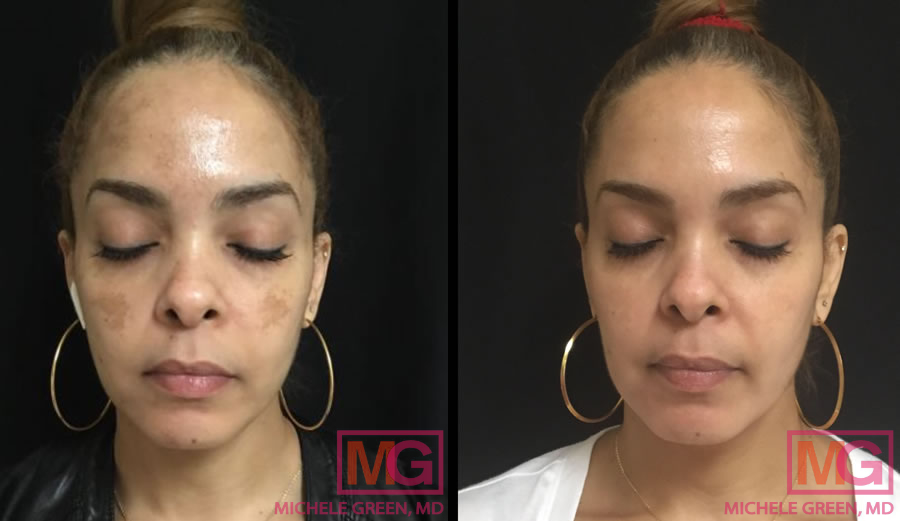
Cosmelan – 10 weeks before and after
Which chemical peel is the best for melasma?
When treating any form of hyperpigmentation, including melasma, Dr. Green recommends using the Cosmelan peel. Melasma is a common skin condition due to an overproduction of melanin in the skin, resulting in brown or gray patches on the skin’s surface. Melasma commonly appears on the face and can be easily treated at a dermatologist’s office with a Cosmelan peel. The Cosmelan peel contains five key ingredients – kojic acid, azelaic acid, arbutin, phytic acid, and ascorbic acid – which inhibit melanin production by melanocytes in the skin. Further, the chemical peel exfoliates the pigmented layer of skin for lighter, clearer skin.
Will a chemical peel remove moles?
Moles are brown spots that form on the body when the melanin-producing cells, known as melanocytes, cluster together to form a dark spot. Moles are common and often harmless, though the development of moles in adulthood with irregular borders that change in shape and size may be evidence of cancerous growth and should be checked out by your dermatologist. Many moles are harmless but may be cosmetically undesirable, causing patients to look for a way to remove them. Chemical peels typically do not penetrate the skin deep enough to remove the pigmentation from a mole. There are, however, other effective methods for removing moles. A dermatologist, such as Dr. Green in NYC, may perform shave removal, laser removal, cryotherapy, or excision to remove a mole.
Will chemical peels reduce pore size?
Chemical peels can effectively reduce pore size, and one of the best types of chemical peels for pore size reduction is the Vi Peel, which is made up of salicylic acid, vitamin C, TCA, and retinoid. The Vi Peel can be used to address hyperpigmentation, active acne breakouts, fine lines and reduce the size of the pores on the face. In addition to chemical peels, Dr. Green may turn to the Clear + Brilliant fractionated laser, which helps to treat enlarged pores by creating little micro-wounds that stimulate collagen production and tighten the skin.
Can chemical peels tighten skin?
Chemical peels work by applying a chemical solution that reacts with the dead skin cells and debris on the skin’s surface to slough off any damaged skin cells and reveal new skin underneath. Chemical peels are very effective at improving skin texture and skin tone and can work to tighten the skin. Still, regarding skin tightening treatment, Dr. Green typically recommends the Thermage radiofrequency laser. Thermage is a non-invasive skin-tightening treatment that uses radiofrequency energy to boost the body’s natural collagen production for smoother, tighter, more youthful-looking skin. The treatment can be used on many body parts, including the face, neck, chest, arms, abdomen, thighs, and buttocks.
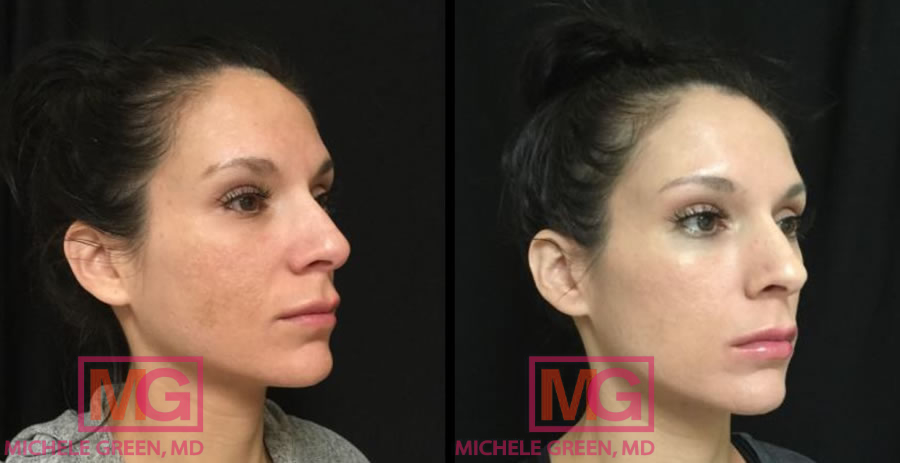
Can chemical peels thin your skin?
Chemical peels have a wide range of uses, including eliminating active acne breakouts, reducing the appearance of acne scars, fine lines, and hyperpigmentation, and improving skin tone and texture. While chemical peel treatment has some potential side effects, they do not thin the skin. Depending on the depth of the peel, patients may experience redness, burning, or irritation on the skin’s surface for several days to several weeks post-treatment. However, these symptoms should resolve in due time.
Can chemical peels be used on the body?
Chemical peels can be effectively used on the face and many body areas, including the neck, chest/decolletage, arms, legs, back, buttocks, inner thighs, and vaginal area. It is important to choose the right peel for the area of the body being treated, as some areas, including the vaginal area, are much more sensitive and thus require a gentler peel. When you have your initial consultation with Dr. Green, she will recommend the type of chemical peel that best treats the area of the body in question.
What types of chemical peel for aging skin?
Many chemical peel options address signs of aging, from reducing the appearance of fine lines and wrinkles to eliminating age spots from the skin’s surface. When you have your initial consultation with Dr. Green, the two of you will discuss your aesthetic goals, and Dr. Green will assess the treatment area to determine the treatment plan that will work best for you. There is no need to visit a plastic surgeon for plastic surgery when it comes to rejuvenating your skin when many non-invasive, non-surgical options are available, including chemical peels. For patients with sensitive skin or who want to reduce the appearance of fine lines, a superficial chemical peel such as a Jessner’s peel may be the best option. Medium-depth peels, such as TCA peels, can be used to address deeper wrinkles, as well as hyperpigmentation such as melasma and sun spots. Mandelic anti-aging chemical peels and retinol-based peels can also be used to refresh, hydrate, and revitalize aging skin.
What types of chemical peel for dark skin?
There is a commonly held belief that chemical peels are unsafe for patients with darker skin tones, but in fact, there are many chemical peel options that are safe and effective for Patients of Color or patients with darker skin. When it comes to chemical peels, People of Color are at a higher risk of developing post-inflammatory hyperpigmentation after receiving a chemical peel, which is when dark patches form on the surface of the skin. That is why it is important to find a dermatologist who has worked with patients of all skin tones, such as Dr. Green, who understands how to treat darker skin. First, it is best to use superficial chemical peels at a lower concentration, such as glycolic and salicylic acid peels. Retinol and Jessner peels are also safe and effective when used at a lower concentration. Medium-depth peels can potentially be dangerous, particularly TCA peels at a 25% or above concentration. Patients with darker skin tones should also avoid all deep chemical peels and any peels containing hydroquinone, as they pose the highest risk of damaging darker skin.
What types of chemical peel for sensitive skin?
For patients with sensitive skin, it is important to choose a gentle peel that will not cause too much irritation to the skin, such as a superficial peel. The gentlest type of superficial peel is the alpha hydroxy acid (AHA) peel, which is best used to reduce fine lines, improve dry skin and minor acne breakouts, and reduce the appearance of small dark spots. The glycolic acid peel is an excellent option for patients with sensitive skin, as it resurfaces the skin and boosts collagen production without causing too much irritation.
What are the different types of chemical peels?
There are three main types of facial chemical peels: superficial peels, medium-depth peels, and deep peels, each serving a different function and being able to address various skin conditions. Superficial peels are the lowest concentration facial peel and are best for reducing the appearance of fine lines, addressing acne, and brightening and hydrating the skin. Most superficial peels are safe and effective for all skin types. Medium-depth peels can be used to treat skin conditions, such as hyperpigmentation, melasma, age spots, and actinic keratosis, as well as address deeper wrinkles and acne scars. Deep chemical peels have the highest concentration of exfoliating ingredients and may require some downtime. Deep chemical peels should not be used on patients with darker skin tones.
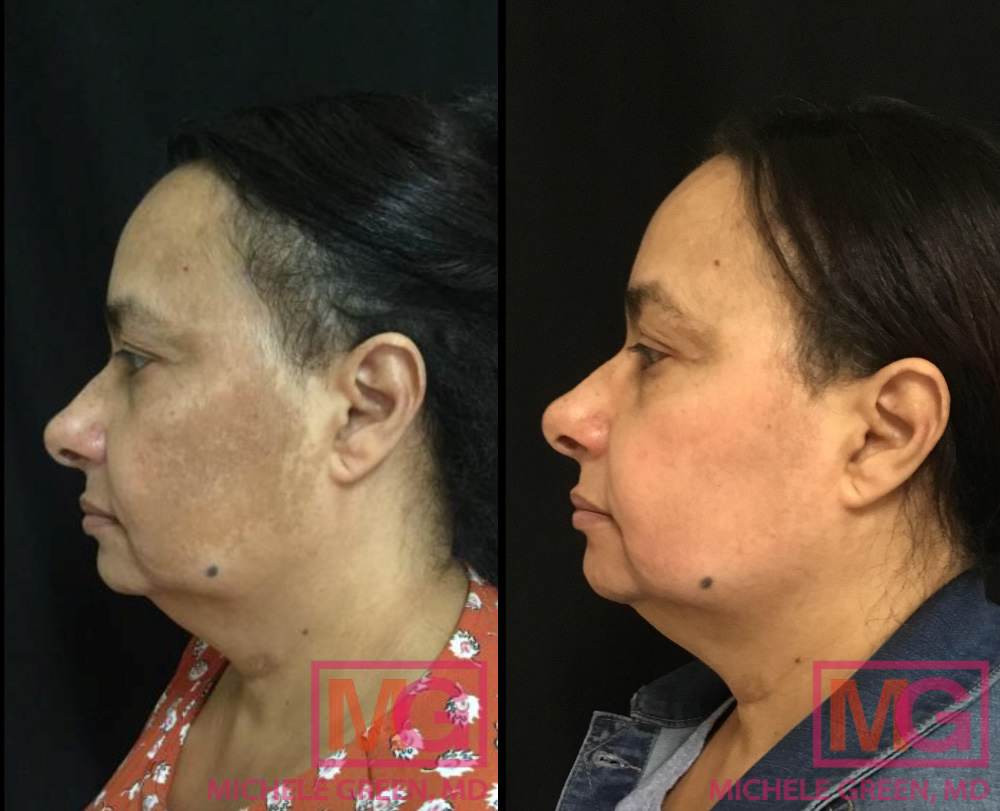
Chemical Peel Before & After – 2 months
What types of facial peels are there?
Within the three categories of facial chemical peels, superficial peels, medium-depth peels, and deep peels, there are many different types of peels with varying ingredients to treat various conditions. Different acids, the main ingredients of chemical peels, will have a chemical reaction with the skin’s surface, which serves to exfoliate the skin, leading to new cell turnover. Different acids and different concentrations of acids will have different results. The most common acid found in the superficial alpha hydroxy acid peels is glycolic acid, which reduces the appearance of fine lines, acne, and mild skin irregularities. Beta hydroxy acid peels often contain salicylic acid, effectively reducing acne. Salicylic acid peels are often combined with Trichloroacetic acid peels, which are medium-depth peels. Deep phenol peels contain carbolic acid as the peeling agent, which addresses more severe skin conditions. When you have your consultation with Dr. Green, she will be able to determine the type of chemical peel that will work best to address your specific needs.
How does laser skin resurfacing compare to chemical peels?
Both chemical peels and laser treatments are cosmetic skin resurfacing procedures that are designed to remove dead skin cells from the top layer of the skin. Both lasers and chemical peels can be used to rejuvenate the skin, reduce pigmentation or sun damage, and make the skin smoother and firmer. However, depending on your skin condition or skin type, you may be better suited for one treatment over the other.
Various laser treatments and chemical peels can safely treat those with a lighter skin tone, but unfortunately, those with a darker skin tone can be sensitive to certain lasers. Dr. Green has helped a variety of patients to reduce the appearance of hyperpigmentation that has been caused by lasers and therefore encourages patients to do their research before considering laser skin resurfacing. Dr. Green will always work with you to determine if a chemical peel or laser skin resurfacing treatment is best for you.
How many types of chemical peels are there?
The four most common types of chemical peels are AHA peels, BHA peels, TCA peels, and Phenol peels. AHA and BHA peels are classified as light chemical peels, whereas TCA peels are defined as medium-depth peels and Phenol peels are labeled as deep peels. However, the chemical solution of a peel can be custom designed for a patient to optimize results, which leads to various possible acid combinations and concentrations. Dr. Green is an expert in determining which chemical solution is best for each patient.
Who performs chemical peels?
Depending on the chemical peel’s type, strength, and PH content, it may only be provided by an authorized physician. A licensed aesthetician can generally perform superficial peels, whereas deeper peels require a licensed medical professional. A chemical peel experience provided by a certified medical professional will provide you with the tailored chemical peel experience you need to achieve optimal results. A board-certified dermatologist such as Dr. Green is incredibly knowledgeable about how chemical solutions affect different skin types and conditions.
Can I perform a chemical peel at home?
If you want to perform a chemical peel at home, it is best to begin by consulting with a board-certified dermatologist, such as Dr. Green, to find out which type of chemical peel will be safe and effective for your skincare routine. Any chemical peel that can be used at home should be gentle and superficial and used to treat mild skin discoloration, acne breakouts, and fine lines that form on the face. It is vitally important not to over-exfoliate the treatment area, as this can cause irritation and damage to the skin. If you are using a chemical peel at home, be sure to follow the instructions given to you by your dermatologist to avoid any side effects of the treatment.
Why choose Dr. Green for a chemical peel?
Dr. Green is a veteran in the world of cosmetic dermatology and specializes in skin rejuvenation and revitalization. Her goal with any treatment is to ensure the safety and satisfaction of her patient, and she will work with you to create a curated skin care treatment plan that maximizes results while minimizing downtime. Dr. Green will help you feel like the best “you” possible through her care and expertise.
What is the best type of chemical peel?
Though it may surprise you, no “best” type of chemical peel exists. The best chemical peel for you will always be different than the best chemical peel for another patient, as a chemical peel must be matched with your skin type, tone, condition, and area of the body. In general, fair-skinned patients can be treated with stronger chemical peels than patients with darker skin tones, but again this varies depending on the needs and skin condition of the patient. Dr. Green always works with her patients to best match the chemical peel with their particular skin type and is incredibly knowledgeable in treating patients with all skin types and skin tones.
How do I get started with a chemical peel?
Suppose you are looking for a way to revitalize your skin and rejuvenate your appearance. In that case, a chemical peel is an excellent non-invasive treatment option that will provide you with the cosmetic results you’re after. Chemical peels are a completely customizable treatment option that can target and resolve many skin conditions, including acne scars, age spots, discoloration, fine lines and wrinkles, melasma, and even rosacea. Chemical peels are designed to exfoliate the skin and eliminate dead skin cells from the top layer, allowing for healthier, brighter, more youthful-looking skin. Dr. Green often incorporates chemical peels into her patients’ treatment plans as they are a quick, painless way to achieve an overall improved complexion without any downtime whatsoever.
If you want to refresh your skin’s look and feel via chemical peel treatment, Dr. Green is here to help. Dr. Green is a board-certified cosmetic dermatologist with over 25 years of experience providing the best non-invasive cosmetic treatments, from Botox, Juvederm, Fraxel, Thermage, CoolSculpting, and laser treatments. Her dedication to her patients and practice is well-reflected because she is consistently voted one of New York’s best physicians by New York Magazine, Super Doctors, and Castle Connolly. To learn more about chemical peels and other non-invasive cosmetic treatments that will leave you looking and feeling like the best version of yourself, contact the office today to schedule a consultation with Dr. Green or call 212-535-3088 to create a customized skincare treatment plan for you.
 212-535-3088
212-535-3088